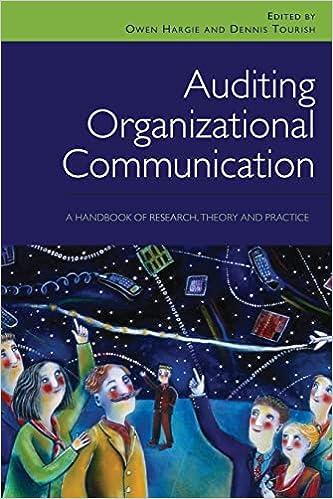Answered step by step
Verified Expert Solution
Question
1 Approved Answer
on August 31, 2018, Divine Floral Supply had a $165,000 debit balance in Accounts Receivable and a $6,600 credit balance in Allowances for Bad Debts.
on August 31, 2018, Divine Floral Supply had a $165,000 debit balance in Accounts Receivable and a $6,600 credit balance in Allowances for Bad Debts. During September, Divine made: 








Requirements 1. Journalize all September entries using the allowance method. Bad debts expense was estimated at 2% of credit sales. Show all September activity in Accounts Receivable, Allowance for Bad Debts, and Bad Debts Expense (post to these T-accounts). 2. Using the same facts, assume that Divine used the direct write-off method to account for uncollectible receivables. Journalize all September entries using the direct write-off method. Post to Accounts Receivable and Bad Debts Expense, and show their balances at September 30, 2018. 3. What amount of Bad Debts Expense would Divine report on its September income statement under each of the two methods? Which amount better matches expense with revenue? Give your reason. 4. What amount of net accounts receivable would Divine report on its September 30, 2018, balance sheet under each of the two methods? Which amount is more realistic? Give your reason. Print Done Requirement 1. Journalize all September entries using the allowance method. Bad Debts Expense was estimated at 2% of credit sales. Show all September activity in Accounts Receivable, Allowance for Bad Debts, and Bad Debts Expense (post to these T-accounts). Begin by journalizing all September entries using the allowance method. (Record debits first, then credits. Select the explanation on the last line of the journal entry table.) Debit Credit Sales on account, $590,000. Ignore Cost of Goods Sold. Date Accounts and Explanation Sep. 30 Accounts Receivable Sales Revenue 590,000 590,000 Record sales for the month. Collections on account, $627,000. Date Accounts and Explanation Credit Debit 627,000 Sep. 30 Cash Accounts Receivable 627,000 Collected cash on account. Write-offs of uncollectible receivables, $8,000. Date Credit Accounts and Explanation Allowance for Bad Debts Accounts Receivable Debit 8,000 Sep. 30 8,000 Wrote off uncollectible accounts. Journalize the Bad Bebts Expense for September using the allowance method, bag vedts Expense was su credit sales. LETU Date Debit Credit Sep. 30 Accounts and Explanation Bad Debts Expense Allowance for Bad Debts 11,800 11,800 Recorded bad debts expense for the period. Post all September entries in the appropriate T-accounts and calculate the ending balance in each account. (Enter the beginning balance if applicable. Then post the transactions and calculate the account balance at September 30, 2018.) Accounts Receivable Aug. 31, 2018 Bal. 165,000 627,000 590,000 8,000 Sep. 30, 2018 Bal. 120,000 Allowance for Bad Debts 8,000 Aug. 31, 2018 Bal. 11,800 Bad Debt Expense Requirement 2. Using the same facts, assume that Divine used the direct write-off method to account for uncollectible receivables. Journalize all September entries using the direct write-off method. Post to Accounts Receivable and Bad Debts Expense, and show their balances at September 30, 2018. Begin by journalizing all September entries using the direct write-off method. (Record debits first, then credits. Select the explanation on the last line of the journal entry table.) Sales on account, $590,000. Ignore Cost of Goods Sold. Date Accounts and Explanation Debit Credit Sep. 30 Collections on account, $627,000 Date Accounts and Explanation Debit Credit Sep. 30 Write-offs of uncollectible receivables, $8,000. Date Accounts and Explanation Debit Credit Sep. 30 Post to Accounts Receivable and Bad Debts Expense and show their balances at September 30, 2018. (Enter the beginning balance if applicable. Then post the transactions and calculate the account balance at September 30, 2018.) Accounts Receivable Bad Debt Expense Requirement 3. What amount of Bad Debts Expense would Divine report on its September income statement under each of the two methods? Which amount better matches expense with revenue? Give your reason. Enter the amount of bad debt expense Divine would report on its September 30, 2018 income statement under each of the two methods. Allowance Method Direct Write-Off Method Income Statement (Partial) Bad Debts Expense better matches expense with revenue because the expense is Bad Debts Expense under the recorded Requirement 4. What amount of net accounts receivable would Divine report on its September 30, 2018, balance sheet under each of the two methods? Which amount is more realistic? Give your reason. Enter the amount of net accounts receivable Divine would report on its September balance sheet under each of the two methods. (Complete all answer boxes. For accounts with a $0 balance, make sure to enter "0" in the appropriate column.) Allowance Method Direct Write-Off Method Balance Sheet (Partial): Accounts receivable Less: Allowance for Bad Debts is more realistic because it shows the amount of the receivables Net accounts receivable under the that the company - Sales on account $590,000. Ignore Codt of Goods Sold.
- Collections on account, $627,000.
- Write-Offs of uncollectible receivables, $8,000.









Step by Step Solution
There are 3 Steps involved in it
Step: 1

Get Instant Access to Expert-Tailored Solutions
See step-by-step solutions with expert insights and AI powered tools for academic success
Step: 2

Step: 3

Ace Your Homework with AI
Get the answers you need in no time with our AI-driven, step-by-step assistance
Get Started


